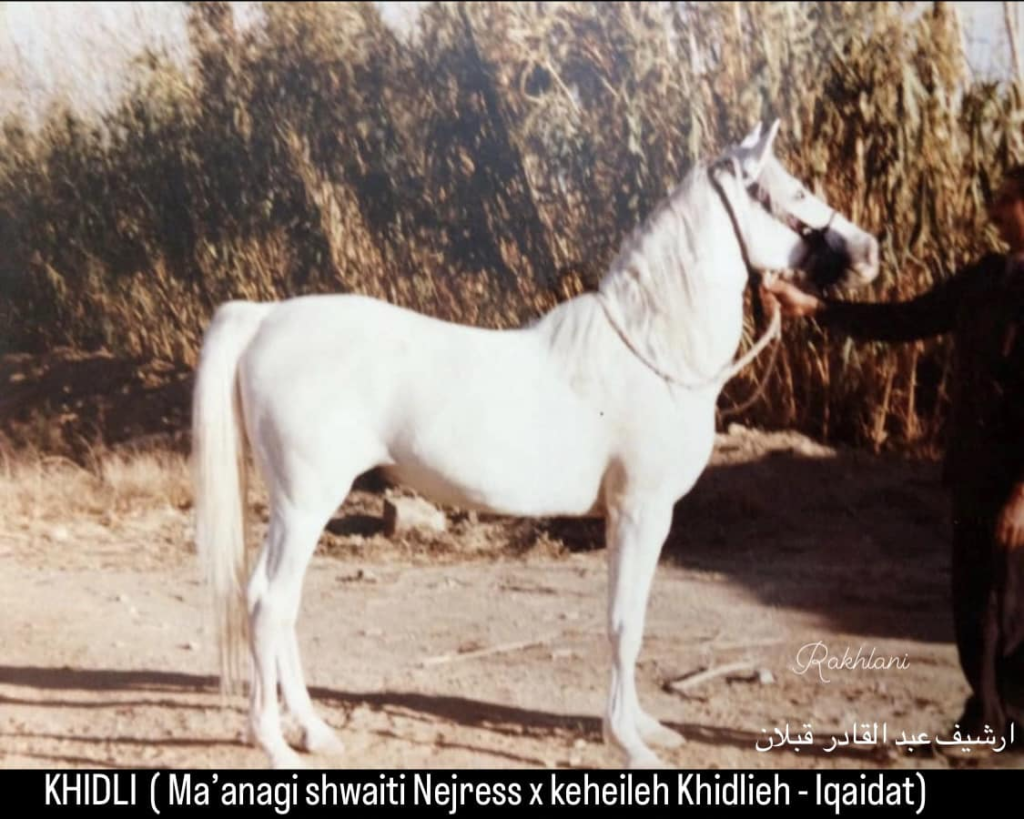The Khdili of Abbud Ali al-Amud in the Aldahdah Index
I have not looked at my “Aldahdah Index” in a while. It is a compendium of standardized entries on older Middle Eastern Arabian horses, mostly Syrian and Lebanese, in the style of the Raswan Index. I will publish it one day. I looked up the entry of the Khdili stallion of Abbud Ali al-Amud, who has recently been the subject of discussion on social media (Facebook and WhatsApp groups). I had written this about him back then:
AL-KHDILI OF ABOUD ALI AL-AMOUD: an Asil desert-bred stallion; later owned by the Armenian horsedealer Apo in Aleppo.
Strain: Kuhaylan Khdili, of the marbat owned by ‘Abbud ‘Ali al-‘Amud, a Bedouin from the Aqaydat tribe; al-‘Amud got his horses from the marbat of ‘Udayb al-Waqqa’ of the Saba’ah tribe.
Comments: He was a small horse of such classic Arab type, with such an extreme head, that people in Aleppo were reluctant to use him because they found him to be ‘pretty like a mare’. He is closely related to the beautiful mare Leelas, a Kuhaylah Khdiliyah bred by ‘Abbud ‘Ali Al-‘Amud, and which is a daughter of the Ma’naqi al-Shwaiti al-Najrissi of the Aqaydat tribe.
That was what I had about him some twenty five years ago. In 2017, I wrote about him in passing here.
A few days ago, Khalid Rakhlani got in touch with the children of his last owner, Damascus breeder Abd al-Qadir Qabalan. They shared with him two precious photos of this Kuhaylan Khdili stallion, below:


Khalid also told me that it was the consul of Qatar in Syria, the late Yusuf al-Rumaihi, a true passionate about authentic Syrian horses, who told Qabalan about the stallion’s whereabouts and encouraged him to obtain him. This makes a lot of sense, because I knew already that the late Yusuf al-Rumaihi was very fond of the stallion’s sister, Leelas. Rumaihi had tried very hard to obtain her from her breeder and owner ‘Abbud ‘Ali al-‘Amud, but the latter would not sell at any price. Rumaihi was eventually able to lease her for one year only. He bred her to his Straight Egyptian stallion Okaz (Wahag x Nazeemah). She produced a filly (named Khaznah) that later went to Qatar. ‘Abbud ‘Ali al-‘Amud was reportedly so upset that his mare was bred to an Egyptian stallion that he swore to not breed her again until he found a stallion worthy of her. When years later he later he saw the chestnut Hamdani Ibn Ghurab stallion Al-Aawar, he deemed him was worthy of his mare and sent to breed her to him. The outcome was the Kuhaylan al-Khdili Saad Al-Thani, one of my favorite Syrian stallions.
He is a very attractive little horse; I admit his head does not look all that extreme to me, but that may be the angle and the halter disguising it.
What made Okaz so unacceptable to ‘Abbud ‘Ali al-‘Amud? Was it that as an Egyptian stallion, he fell outside the ability of local networks to authenticate him?
Exactly. Okaz was “foreign” to the Bedouin world. He could not relate to him, nor put him in a box in his Bedouin frame.
Thank you for the explanation!
Edouard avait vous eu connaissance de cette histoire d’une ascendante de Leelass et donc de Kihdli qui a permis de revenir sains et saufs à deux parents d’ Abbud Ali al-Amud lors d’une course poursuite en retour d’Irak ?
Bonjour Arnault, je ne me souviens plus si l’histoire se rapportait a Leelas/Khdili ou a une autre jument des Aqaydat, Nawal en l’occurence (Ubayyah Sharrakiyah)
I like this fellow. He reminds me of a Davenport stallion, Ibn Dharantez, a Kuhaylan Haifi.